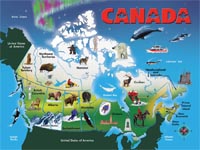Ontario: Canada's wet, wild and occasionally tranquil wonderland
 Wabatongushi, Canada - It's only the rare motorboat off in the distance that breaks the quiet here. The small wooden canoe rocks in the waves, but otherwise it's quiet on Wabatongushi Lake.
Wabatongushi, Canada - It's only the rare motorboat off in the distance that breaks the quiet here. The small wooden canoe rocks in the waves, but otherwise it's quiet on Wabatongushi Lake.
"Some fish has to bite some time," says Adam Madahbee as he looks out on this lake in the northern part of Canada's most watery province.
He says this even though it's been two hours and all of his fellow fishermen have given up hope. But suddenly his fishing rod gives a shake. The 25-year-old dives across the boat, grabs a net and, in the next moment, heaves a silvery-green fish on board, a flopping walleye.
Like sturgeon, catfish and pangolin, walleyes are everywhere in the seemingly never-ending waterways of Ontario. Nonetheless, Adam is disappointed as he gets back to shore. He didn't get any bites beyond the walleye.
His grandfather, Ivan, didn't have any luck today either. The 75- year-old continues to hold his rod in the sparkling water long after his grandson has moored his boat on land. Out on an island in the lake, Adam and Ivan manage to deck an impressive table with some fish they brought with them and crispy potato wedges, all prepared over a wood fire. The only catch of the day lands in the griddle.
The narrow Wabatongushi Lake stretches 30 kilometres north to south and lies in the Cahpleau Crown Game Preserve. The largest wildlife reserve in the world isn't far from the shores of Lake Superior, the largest inland lake in Canada.
This is where the parents of Al Errington, Ivan and Adam's boss, started to build a lodge in the middle of the wilderness in the mid 1970s. Nowadays, Al and his wife Doris offer a getaway for stressed out city people five months of the year.
Canada has about 10 per cent of the world's fresh water supplies. The bulk of those lie in Ontario. The province borders the Great Lakes in the south and brushes against the Hudson Bay to the north. A sixth of Ontario's area is taken up by lakes and rivers. There are supposed to be 400,000 bodies of water.
Guests of Al and Doris either live in suites near the main building or in wooden cabins on the neighbouring island. Anyone who doesn't want to tromp through the woods to get to breakfast in the main house can just use their personal motorboat. Every cabin has its own private dock, plus a canoe.
Nature lovers relax on the terraces, swim in the lake or keep lookout for moose, beavers, otters and black bears, to say nothing of loons, hummingbirds and bald eagles.
Adam and Ivan belong to a branch of the Anniishnabe, in turn part of the Ojibway, one of the larger first nations, or groups representing the original occupants of Canada. They come from Manitoulin Island, a region very similar to the Chapleau reserve.
About two hours by plane from Lake Wabatongushi, the 2,800-square- kilometre island in Lake Huron is the world's largest island in the middle of an inland lake.
The lake lies near Georgian Bay, which is, in turn, along a major former fur trading route. Eileen and David Quinn like to tell visitors that the canal between the small village of Killarney and Georges Island, which lies upstream, provided good protection from bad weather for fur traders in the bay.
The couple, both in their late 50s, sailed through the Caribbean 12 years ago. But neither the former musician nor the former journalist was ready to completely return to land. Instead, they've spent the last three years steering the sailboat Stormy Night through the bay and the waters around Manitoulin Island.
Three times a week, the Quinns take tourists to the hidden corners of this land of islands. One secret tip for a day trip from Killarney is a visit to Fox Island, says David. "Only locals sail here, since the bay is a white spot on most maps."
Hardly any sailboats come to the provincial park at French River, but the area is a paradise for whitewater rafting, paddleboats, fishermen and swimmers. The river connects Lake Nipissing with the Georgian Bay. Sometimes wider, sometimes narrower, the river wends its way between gray-white granite boulders and tree-covered hills.
The region isn't quite as lonely as the Chapleau Wildlife Reserve, which lies further north. But Adam Madahbee still wouldn't trade homes. "When you see the great area up here, then you're not really wanting for anything," he says, pointing to the glistening water.
Information: Canadian Tourism Commission, c/o Lange Touristik- Dienst, Eichenheege 1-5, 63477 Maintal (Tel: ++ 49-1805 52 62 32); Ontario Tourism, 10 Dundas Street East, Suite 900, Toronto, Ontario, Canada M7A 2A1 (Tel: ++1-800-668-2746; Internet: www. canada. travel, www. ontariotravel. net, www. cca-acc. org. (dpa)